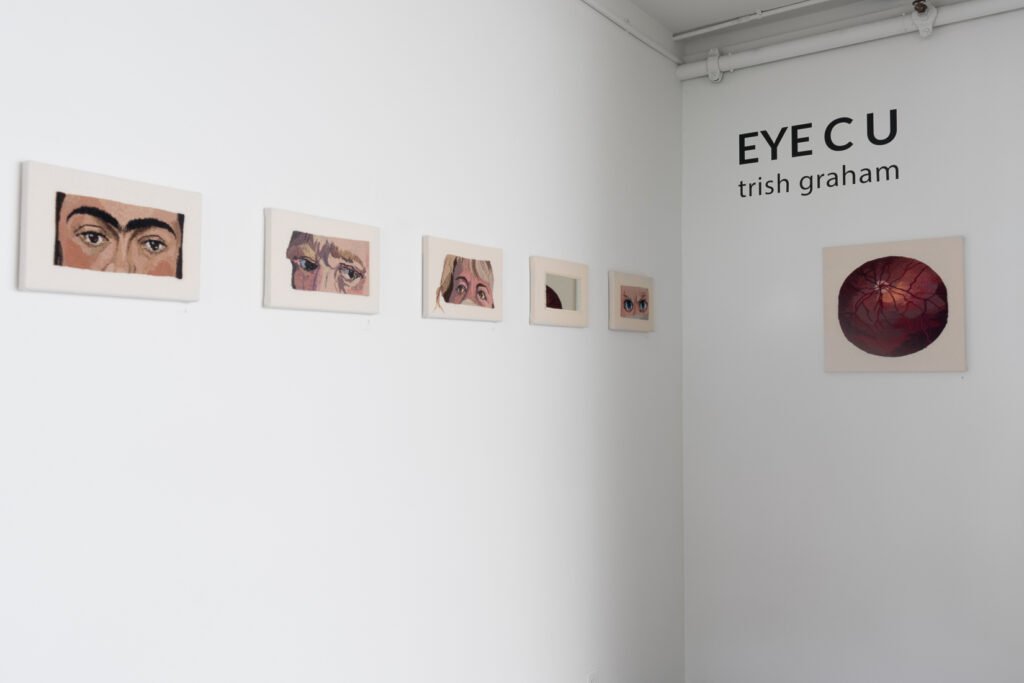Artist Cathy Joyce reflects on her experience of Trish Graham’s exhibition EYE C U. Here, Cathy discusses how Trish’s work breathes life back into images of faces; life lost in the age of the selfie.Trish brings us closer to an understanding of the characters she has stitched, even those we have not had the pleasure of interacting with many of these characters in our time their expression is felt.
EYE C U is on view in our gallery until October 7, 2021.
If the eyes are the windows to the soul then staring endlessly at faces who are, in their turn, staring at webcams and cellphone screens has stopped us from seeing the light behind those portals. In the warmth of her stitched images, Trish Graham captures that lost inner glow, glimpsed through many pairs of eyes gazing at us from familiar, historical, and personal portraits. The frozen pose of the ‘selfie’ lacks the passion that art has sought across time, and evades the telling signals that Le Brun, cited by Graham, worked to codify (though it often includes the flattery he put into his court commissions). This exhibition rediscovers deeper emotions found by earlier portraitist in the details of faces, and renders them in the slow and purposeful process of tapestry making.
“Trish Graham captures that lost inner glow, glimpsed through many pairs of eyes gazing at us from familiar, historical, and personal portraits.“
EYE C U revisits the honesty found in the best portraiture, questioning how we engage with what it reveals. There is a trust in asking an artist to create one’s image for posterity; a choice to allow a critical gaze, which is missing from the Instagram-filtered selfie posted to grab the attention of the idle scroller. To create a real portrait the sitter and artist spend time together, the maker’s eyes never leaving the face, exploring the nuances of expression and physiognomy there, often making sketches to catch different traits. The relationship of a tapestry maker to an image is similarly drawn together from carefully selected sketches, shared in some of the pieces here. By including faces deliberately stopped in progress, work floating in a ripple of the threads from which it is formed, and by working in the gallery herself, Trish Graham invites the visitor to explore the insights of the original painter or photographer, even mosaic maker: insights on which she has built this work.


In the piece most obviously taken directly from life, the cover image for the catalogue, the stitching takes us deep into the corner of the maker’s eye: the blood that feeds her instinctive understanding gained through acute visual awareness. This kind of visceral engagement directs our interactions with the other eyes she has looked into and stitched.
The texture of the woolen stitches brings the viewer close enough to touch the skin of people, some of whom lived over a millennium ago, captured in this almost sculptural way. There is an invitation to touch some work, completing a sensory connection with a distant human being. Other pieces enclose just the eyes, larger than life size, in a sharp rectangular slot while the rest of the face is masked.
There are diverse, famous contemporary faces and others associated with ancient times: the kind found on the cover images of text books. However, here, their softly woven features have a deeper sense of history than the short hand of Wikipedia. It is through the care and the skill taken in the execution of these completed images, and the un-stitched yarns deliberately left with part of their story untold, that we are drawn into by the presence of real people and asked to question our assumptions about them.
Every visitor will find the eyes that speak to them most directly, whether the boldly delineated Romans, one even looks a little bored, or the raptured features attributed to a saint. For me, it was the delicate colours conveying so much personal struggle used in the ‘selfie’ of Vincent Van Gogh. There is a tenderness in this re-imagining that perhaps the painter did not offer himself in the original, but which will inform the way that I look back at other eyes I encounter, even over the top of a mask.


